Variational Inference: Bayesian Neural Networks¶
- 2016 by Thomas Wiecki
Original blog post: http://twiecki.github.io/blog/2016/06/01/bayesian-deep-learning/
Current trends in Machine Learning¶
There are currently three big trends in machine learning: Probabilistic Programming, Deep Learning and “Big Data”. Inside of PP, a lot of innovation is in making things scale using Variational Inference. In this blog post, I will show how to use Variational Inference in PyMC3 to fit a simple Bayesian Neural Network. I will also discuss how bridging Probabilistic Programming and Deep Learning can open up very interesting avenues to explore in future research.
Probabilistic Programming at scale¶
Probabilistic Programming allows very flexible creation of custom probabilistic models and is mainly concerned with insight and learning from your data. The approach is inherently Bayesian so we can specify priors to inform and constrain our models and get uncertainty estimation in form of a posterior distribution. Using MCMC sampling algorithms we can draw samples from this posterior to very flexibly estimate these models. PyMC3 and Stan are the current state-of-the-art tools to consruct and estimate these models. One major drawback of sampling, however, is that it’s often very slow, especially for high-dimensional models. That’s why more recently, variational inference algorithms have been developed that are almost as flexible as MCMC but much faster. Instead of drawing samples from the posterior, these algorithms instead fit a distribution (e.g. normal) to the posterior turning a sampling problem into and optimization problem. ADVI – Automatic Differentation Variational Inference – is implemented in PyMC3 and Stan, as well as a new package called Edward which is mainly concerned with Variational Inference.
Unfortunately, when it comes to traditional ML problems like classification or (non-linear) regression, Probabilistic Programming often plays second fiddle (in terms of accuracy and scalability) to more algorithmic approaches like ensemble learning (e.g. random forests or gradient boosted regression trees.
Deep Learning¶
Now in its third renaissance, deep learning has been making headlines repeatadly by dominating almost any object recognition benchmark, kicking ass at Atari games, and beating the world-champion Lee Sedol at Go. From a statistical point, Neural Networks are extremely good non-linear function approximators and representation learners. While mostly known for classification, they have been extended to unsupervised learning with AutoEncoders and in all sorts of other interesting ways (e.g. Recurrent Networks, or MDNs to estimate multimodal distributions). Why do they work so well? No one really knows as the statistical properties are still not fully understood.
A large part of the innoviation in deep learning is the ability to train these extremely complex models. This rests on several pillars: * Speed: facilitating the GPU allowed for much faster processing. * Software: frameworks like Theano and TensorFlow allow flexible creation of abstract models that can then be optimized and compiled to CPU or GPU. * Learning algorithms: training on sub-sets of the data – stochastic gradient descent – allows us to train these models on massive amounts of data. Techniques like drop-out avoid overfitting. * Architectural: A lot of innovation comes from changing the input layers, like for convolutional neural nets, or the output layers, like for MDNs.
Bridging Deep Learning and Probabilistic Programming¶
On one hand we Probabilistic Programming which allows us to build rather small and focused models in a very principled and well-understood way to gain insight into our data; on the other hand we have deep learning which uses many heuristics to train huge and highly complex models that are amazing at prediction. Recent innovations in variational inference allow probabilistic programming to scale model complexity as well as data size. We are thus at the cusp of being able to combine these two approaches to hopefully unlock new innovations in Machine Learning. For more motivation, see also Dustin Tran’s recent blog post.
While this would allow Probabilistic Programming to be applied to a much wider set of interesting problems, I believe this bridging also holds great promise for innovations in Deep Learning. Some ideas are: * Uncertainty in predictions: As we will see below, the Bayesian Neural Network informs us about the uncertainty in its predictions. I think uncertainty is an underappreciated concept in Machine Learning as it’s clearly important for real-world applications. But it could also be useful in training. For example, we could train the model specifically on samples it is most uncertain about. * Uncertainty in representations: We also get uncertainty estimates of our weights which could inform us about the stability of the learned representations of the network. * Regularization with priors: Weights are often L2-regularized to avoid overfitting, this very naturally becomes a Gaussian prior for the weight coefficients. We could, however, imagine all kinds of other priors, like spike-and-slab to enforce sparsity (this would be more like using the L1-norm). * Transfer learning with informed priors: If we wanted to train a network on a new object recognition data set, we could bootstrap the learning by placing informed priors centered around weights retrieved from other pre-trained networks, like GoogLeNet. * Hierarchical Neural Networks: A very powerful approach in Probabilistic Programming is hierarchical modeling that allows pooling of things that were learned on sub-groups to the overall population (see my tutorial on Hierarchical Linear Regression in PyMC3). Applied to Neural Networks, in hierarchical data sets, we could train individual neural nets to specialize on sub-groups while still being informed about representations of the overall population. For example, imagine a network trained to classify car models from pictures of cars. We could train a hierarchical neural network where a sub-neural network is trained to tell apart models from only a single manufacturer. The intuition being that all cars from a certain manufactures share certain similarities so it would make sense to train individual networks that specialize on brands. However, due to the individual networks being connected at a higher layer, they would still share information with the other specialized sub-networks about features that are useful to all brands. Interestingly, different layers of the network could be informed by various levels of the hierarchy – e.g. early layers that extract visual lines could be identical in all sub-networks while the higher-order representations would be different. The hierarchical model would learn all that from the data. * Other hybrid architectures: We can more freely build all kinds of neural networks. For example, Bayesian non-parametrics could be used to flexibly adjust the size and shape of the hidden layers to optimally scale the network architecture to the problem at hand during training. Currently, this requires costly hyper-parameter optimization and a lot of tribal knowledge.
Bayesian Neural Networks in PyMC3¶
Generating data¶
First, lets generate some toy data – a simple binary classification problem that’s not linearly separable.
In [1]:
%matplotlib inline
import theano
floatX = theano.config.floatX
import pymc3 as pm
import theano.tensor as T
import sklearn
import numpy as np
import matplotlib.pyplot as plt
import seaborn as sns
sns.set_style('white')
from sklearn import datasets
from sklearn.preprocessing import scale
from sklearn.cross_validation import train_test_split
from sklearn.datasets import make_moons
/home/wiecki/miniconda3/lib/python3.5/site-packages/sklearn/cross_validation.py:44: DeprecationWarning: This module was deprecated in version 0.18 in favor of the model_selection module into which all the refactored classes and functions are moved. Also note that the interface of the new CV iterators are different from that of this module. This module will be removed in 0.20.
"This module will be removed in 0.20.", DeprecationWarning)
In [2]:
X, Y = make_moons(noise=0.2, random_state=0, n_samples=1000)
X = scale(X)
X = X.astype(floatX)
Y = Y.astype(floatX)
X_train, X_test, Y_train, Y_test = train_test_split(X, Y, test_size=.5)
In [3]:
fig, ax = plt.subplots()
ax.scatter(X[Y==0, 0], X[Y==0, 1], label='Class 0')
ax.scatter(X[Y==1, 0], X[Y==1, 1], color='r', label='Class 1')
sns.despine(); ax.legend()
ax.set(xlabel='X', ylabel='Y', title='Toy binary classification data set');
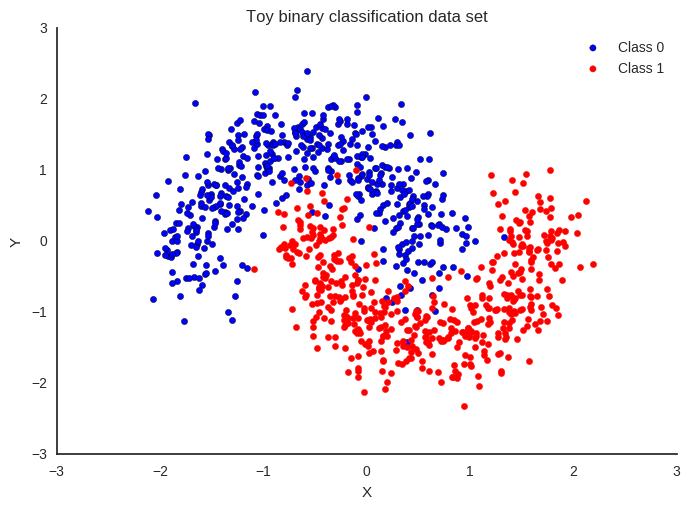
Model specification¶
A neural network is quite simple. The basic unit is a perceptron which is nothing more than logistic regression. We use many of these in parallel and then stack them up to get hidden layers. Here we will use 2 hidden layers with 5 neurons each which is sufficient for such a simple problem.
In [4]:
# Trick: Turn inputs and outputs into shared variables.
# It's still the same thing, but we can later change the values of the shared variable
# (to switch in the test-data later) and pymc3 will just use the new data.
# Kind-of like a pointer we can redirect.
# For more info, see: http://deeplearning.net/software/theano/library/compile/shared.html
ann_input = theano.shared(X_train)
ann_output = theano.shared(Y_train)
n_hidden = 5
# Initialize random weights between each layer
init_1 = np.random.randn(X.shape[1], n_hidden).astype(floatX)
init_2 = np.random.randn(n_hidden, n_hidden).astype(floatX)
init_out = np.random.randn(n_hidden).astype(floatX)
with pm.Model() as neural_network:
# Weights from input to hidden layer
weights_in_1 = pm.Normal('w_in_1', 0, sd=1,
shape=(X.shape[1], n_hidden),
testval=init_1)
# Weights from 1st to 2nd layer
weights_1_2 = pm.Normal('w_1_2', 0, sd=1,
shape=(n_hidden, n_hidden),
testval=init_2)
# Weights from hidden layer to output
weights_2_out = pm.Normal('w_2_out', 0, sd=1,
shape=(n_hidden,),
testval=init_out)
# Build neural-network using tanh activation function
act_1 = pm.math.tanh(pm.math.dot(ann_input,
weights_in_1))
act_2 = pm.math.tanh(pm.math.dot(act_1,
weights_1_2))
act_out = pm.math.sigmoid(pm.math.dot(act_2,
weights_2_out))
# Binary classification -> Bernoulli likelihood
out = pm.Bernoulli('out',
act_out,
observed=ann_output)
That’s not so bad. The Normal priors help regularize the weights.
Usually we would add a constant b to the inputs but I omitted it
here to keep the code cleaner.
Variational Inference: Scaling model complexity¶
We could now just run a MCMC sampler like
`NUTS <http://pymc-devs.github.io/pymc3/api.html#nuts>`__ which
works pretty well in this case but as I already mentioned, this will
become very slow as we scale our model up to deeper architectures with
more layers.
Instead, we will use the brand-new
ADVI variational
inference algorithm which was recently added to PyMC3. This is much
faster and will scale better. Note, that this is a mean-field
approximation so we ignore correlations in the posterior.
In [5]:
%%time
with neural_network:
# Run ADVI which returns posterior means, standard deviations, and the evidence lower bound (ELBO)
v_params = pm.variational.advi(n=50000)
Average ELBO = -136.67: 100%|██████████| 50000/50000 [00:16<00:00, 3095.13it/s]
Finished [100%]: Average ELBO = -134.76
CPU times: user 18.3 s, sys: 360 ms, total: 18.7 s
Wall time: 19 s
< 20 seconds on my older laptop. That’s pretty good considering that NUTS is having a really hard time. Further below we make this even faster. To make it really fly, we probably want to run the Neural Network on the GPU.
As samples are more convenient to work with, we can very quickly draw
samples from the variational posterior using sample_vp() (this is
just sampling from Normal distributions, so not at all the same like
MCMC):
In [6]:
with neural_network:
trace = pm.variational.sample_vp(v_params, draws=5000)
100%|██████████| 5000/5000 [00:00<00:00, 12285.98it/s]
Plotting the objective function (ELBO) we can see that the optimization slowly improves the fit over time.
In [7]:
plt.plot(v_params.elbo_vals)
plt.ylabel('ELBO')
plt.xlabel('iteration')
Out[7]:
<matplotlib.text.Text at 0x7fad0021cb00>
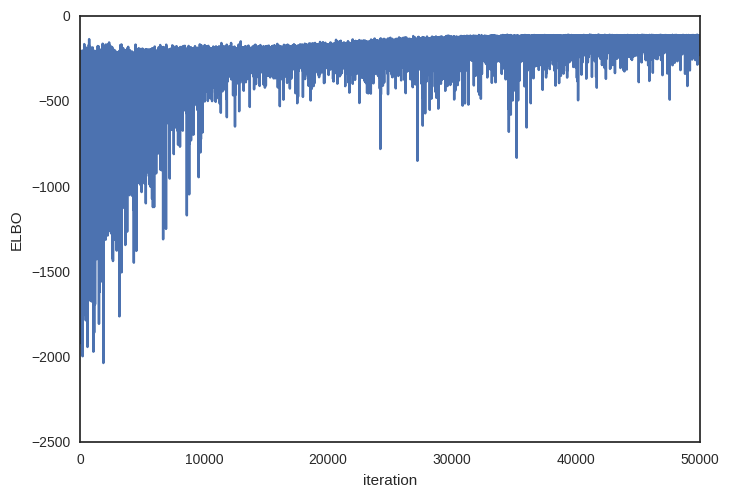
Now that we trained our model, lets predict on the hold-out set using a
posterior predictive check (PPC). We use
`sample_ppc() <http://pymc-devs.github.io/pymc3/api.html#pymc3.sampling.sample_ppc>`__
to generate new data (in this case class predictions) from the posterior
(sampled from the variational estimation).
In [8]:
# Replace shared variables with testing set
ann_input.set_value(X_test)
ann_output.set_value(Y_test)
# Creater posterior predictive samples
ppc = pm.sample_ppc(trace, model=neural_network, samples=500)
# Use probability of > 0.5 to assume prediction of class 1
pred = ppc['out'].mean(axis=0) > 0.5
100%|██████████| 500/500 [00:03<00:00, 140.07it/s]
In [9]:
fig, ax = plt.subplots()
ax.scatter(X_test[pred==0, 0], X_test[pred==0, 1])
ax.scatter(X_test[pred==1, 0], X_test[pred==1, 1], color='r')
sns.despine()
ax.set(title='Predicted labels in testing set', xlabel='X', ylabel='Y');
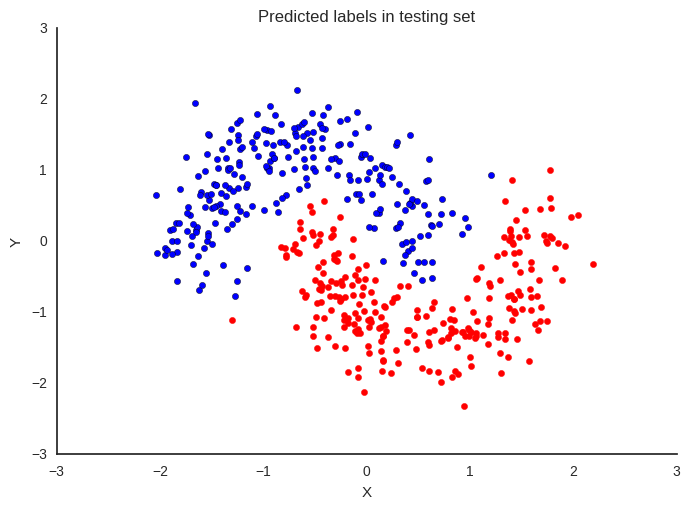
In [10]:
print('Accuracy = {}%'.format((Y_test == pred).mean() * 100))
Accuracy = 97.0%
Hey, our neural network did all right!
Lets look at what the classifier has learned¶
For this, we evaluate the class probability predictions on a grid over the whole input space.
In [11]:
grid = np.mgrid[-3:3:100j,-3:3:100j].astype(floatX)
grid_2d = grid.reshape(2, -1).T
dummy_out = np.ones(grid.shape[1], dtype=np.int8)
In [12]:
ann_input.set_value(grid_2d)
ann_output.set_value(dummy_out)
# Creater posterior predictive samples
ppc = pm.sample_ppc(trace, model=neural_network, samples=500)
100%|██████████| 500/500 [00:04<00:00, 116.49it/s]
Probability surface¶
In [13]:
cmap = sns.diverging_palette(250, 12, s=85, l=25, as_cmap=True)
fig, ax = plt.subplots(figsize=(10, 6))
contour = ax.contourf(*grid, ppc['out'].mean(axis=0).reshape(100, 100), cmap=cmap)
ax.scatter(X_test[pred==0, 0], X_test[pred==0, 1])
ax.scatter(X_test[pred==1, 0], X_test[pred==1, 1], color='r')
cbar = plt.colorbar(contour, ax=ax)
_ = ax.set(xlim=(-3, 3), ylim=(-3, 3), xlabel='X', ylabel='Y');
cbar.ax.set_ylabel('Posterior predictive mean probability of class label = 0');
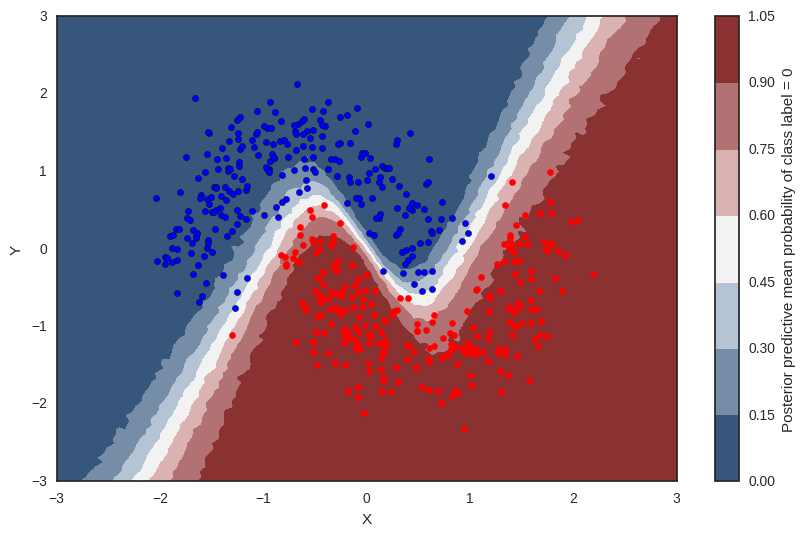
Uncertainty in predicted value¶
So far, everything I showed we could have done with a non-Bayesian Neural Network. The mean of the posterior predictive for each class-label should be identical to maximum likelihood predicted values. However, we can also look at the standard deviation of the posterior predictive to get a sense for the uncertainty in our predictions. Here is what that looks like:
In [14]:
cmap = sns.cubehelix_palette(light=1, as_cmap=True)
fig, ax = plt.subplots(figsize=(10, 6))
contour = ax.contourf(*grid, ppc['out'].std(axis=0).reshape(100, 100), cmap=cmap)
ax.scatter(X_test[pred==0, 0], X_test[pred==0, 1])
ax.scatter(X_test[pred==1, 0], X_test[pred==1, 1], color='r')
cbar = plt.colorbar(contour, ax=ax)
_ = ax.set(xlim=(-3, 3), ylim=(-3, 3), xlabel='X', ylabel='Y');
cbar.ax.set_ylabel('Uncertainty (posterior predictive standard deviation)');
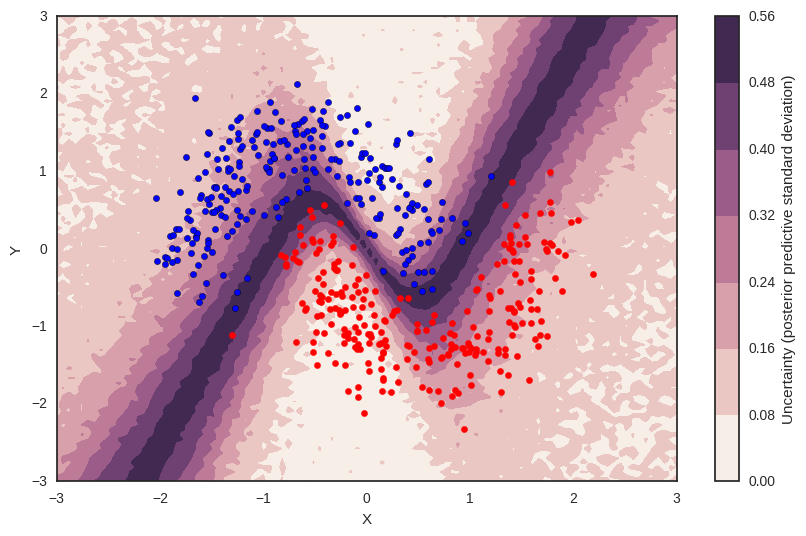
We can see that very close to the decision boundary, our uncertainty as to which label to predict is highest. You can imagine that associating predictions with uncertainty is a critical property for many applications like health care. To further maximize accuracy, we might want to train the model primarily on samples from that high-uncertainty region.
Mini-batch ADVI: Scaling data size¶
So far, we have trained our model on all data at once. Obviously this won’t scale to something like ImageNet. Moreover, training on mini-batches of data (stochastic gradient descent) avoids local minima and can lead to faster convergence.
Fortunately, ADVI can be run on mini-batches as well. It just requires some setting up:
In [15]:
from six.moves import zip
# Set back to original data to retrain
ann_input.set_value(X_train)
ann_output.set_value(Y_train)
# Tensors and RV that will be using mini-batches
minibatch_tensors = [ann_input, ann_output]
minibatch_RVs = [out]
# Generator that returns mini-batches in each iteration
def create_minibatch(data):
rng = np.random.RandomState(0)
while True:
# Return random data samples of set size 100 each iteration
ixs = rng.randint(len(data), size=50)
yield data[ixs]
minibatches = zip(
create_minibatch(X_train),
create_minibatch(Y_train),
)
total_size = len(Y_train)
While the above might look a bit daunting, I really like the design. Especially the fact that you define a generator allows for great flexibility. In principle, we could just pool from a database there and not have to keep all the data in RAM.
Lets pass those to advi_minibatch():
In [16]:
%%time
with neural_network:
# Run advi_minibatch
v_params = pm.variational.advi_minibatch(
n=50000, minibatch_tensors=minibatch_tensors,
minibatch_RVs=minibatch_RVs, minibatches=minibatches,
total_size=total_size, learning_rate=1e-2, epsilon=1.0
)
Average ELBO = -122.96: 100%|██████████| 50000/50000 [00:15<00:00, 3268.69it/s]
Finished minibatch ADVI: ELBO = -88.62
CPU times: user 24.7 s, sys: 3.74 s, total: 28.5 s
Wall time: 1min 1s
In [17]:
with neural_network:
trace = pm.variational.sample_vp(v_params, draws=5000)
100%|██████████| 5000/5000 [00:00<00:00, 15873.94it/s]
In [18]:
plt.plot(v_params.elbo_vals)
plt.ylabel('ELBO')
plt.xlabel('iteration')
sns.despine()
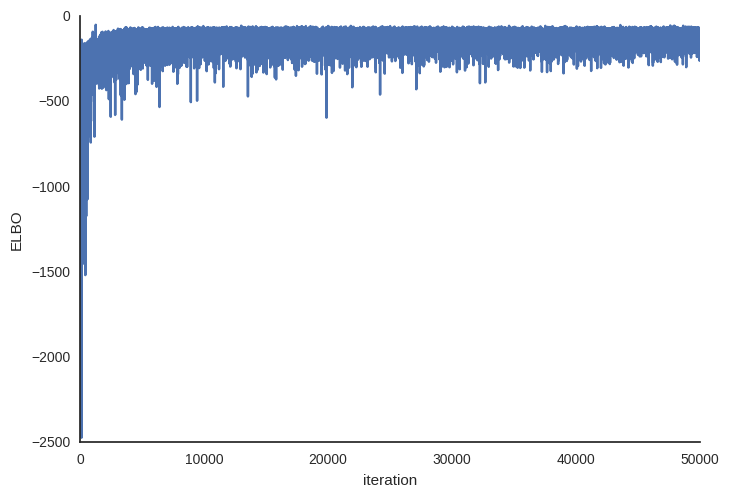
As you can see, mini-batch ADVI’s running time is much lower. It also seems to converge faster.
For fun, we can also look at the trace. The point is that we also get uncertainty of our Neural Network weights.
In [19]:
pm.traceplot(trace);
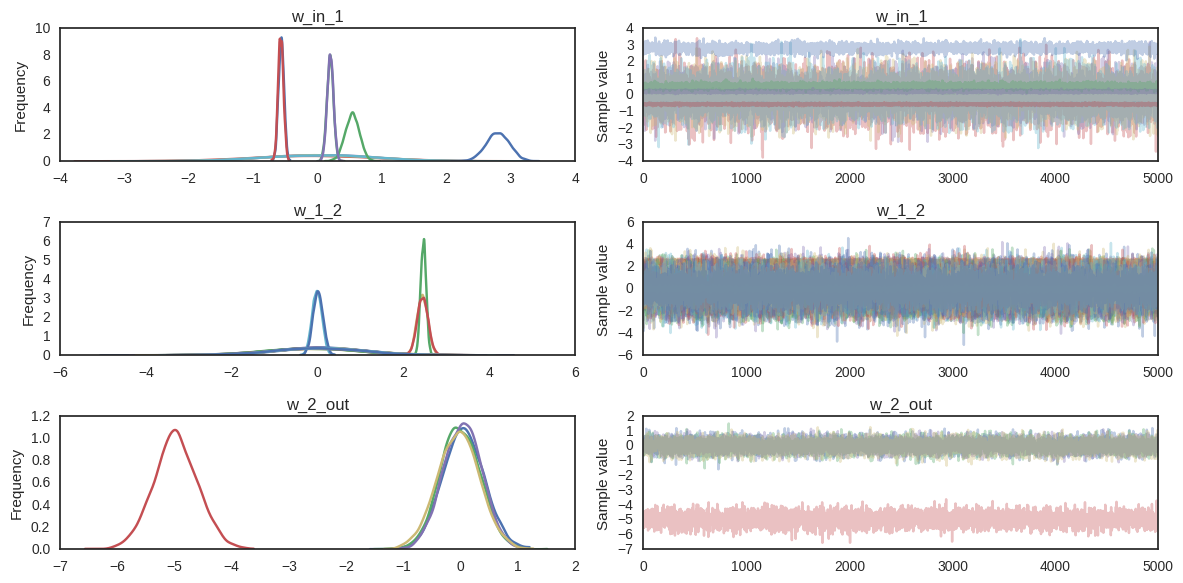
Summary¶
Hopefully this blog post demonstrated a very powerful new inference algorithm available in PyMC3: ADVI. I also think bridging the gap between Probabilistic Programming and Deep Learning can open up many new avenues for innovation in this space, as discussed above. Specifically, a hierarchical neural network sounds pretty bad-ass. These are really exciting times.
Next steps¶
`Theano <http://deeplearning.net/software/theano/>`__, which is used
by PyMC3 as its computational backend, was mainly developed for
estimating neural networks and there are great libraries like
`Lasagne <https://github.com/Lasagne/Lasagne>`__ that build on top
of Theano to make construction of the most common neural network
architectures easy. Ideally, we wouldn’t have to build the models by
hand as I did above, but use the convenient syntax of Lasagne to
construct the architecture, define our priors, and run ADVI.
You can also run this example on the GPU by setting device = gpu and
floatX = float32 in your .theanorc.
You might also argue that the above network isn’t really deep, but note that we could easily extend it to have more layers, including convolutional ones to train on more challenging data sets.
I also presented some of this work at PyData London, view the video below:
Finally, you can download this NB here. Leave a comment below, and follow me on twitter.
Acknowledgements¶
Taku Yoshioka did a lot of work on ADVI in PyMC3, including the mini-batch implementation as well as the sampling from the variational posterior. I’d also like to the thank the Stan guys (specifically Alp Kucukelbir and Daniel Lee) for deriving ADVI and teaching us about it. Thanks also to Chris Fonnesbeck, Andrew Campbell, Taku Yoshioka, and Peadar Coyle for useful comments on an earlier draft.